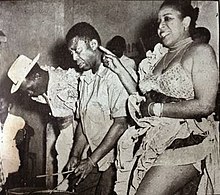 DE BOBOS Y PERSONAJES FAMOSOS CUBANOS: “EL CHORI”.
DE BOBOS Y PERSONAJES FAMOSOS CUBANOS: “EL CHORI”.
Para un cubano ser bobo es lo peor que le puede pasar. En Cuba se perdona todo, menos ser bobo, idiota o come.., según la fraseología popular. Porque los cubanos presumimos de ser listos, avispados, “bichos”, para decirlo en cubano. Y de saber más que ningún otro ser humano de política y de pelota.
Sin embargo, ha habido en Cuba bobos famosos, como el Bobo de Coria, el “Bobo de la Yuca” o el Bobo de Abela.
El Bobo de Coria, aunque popular en Cuba no era realmente cubano; era un bobo importado de Andalucía, donde dicen se había hecho famoso por descubrir quién se había robado la custodia de la iglesia del pueblo (“lo-la-lo-nes”).
El Bobo de la Yuca, fue el personaje central de un son que popularizó el genial Beny Moré. La canción decía que el pintoresco Bobo “se quería casar y que invitaba a todo el mundo para la catedral”.
Pero sin duda el Bobo más popular fue el que creo Eduardo Abela para “La Política Cómica” en tiempos del general Machado. Con su cara regordeta y un globo en la mano, comentaba la actualidad nacional sólo con las expresiones de su cara.
Si usted vivió en La Habana de los años cincuenta del siglo XX, usted debe haber visto este nombre escrito con tiza blanca y letra muy pareja en paredes, portales, aceras, calles y los más curiosos e insospechados lugares de la gran urbe cubana. El nombre de chori aparecía por todas partes.
El Chori era el nombre de un pintoresco personaje de nombre Silvano Schueg, un percusionista nacido en Santiago de Cuba el 6 de enero de 1900. Chori llegó a La Habana en 1927 y comenzó a tocar timbales, tambores y cencerros en distintos cabarets de la Playa de Marianao.
Percutía los instrumentos en forma muy peculiar y llegó a tomar parte en varias películas como Un Extraño en la Escalera y La Pandilla del Soborno. Fue también autor de dos sones: La choricera y Hallaca de Maíz.
Murió en La Habana en abril de 1974.
 ‘BOBOS” AND CUBAN FAMOUS CHARACTERS.”EL CHORI”.
‘BOBOS” AND CUBAN FAMOUS CHARACTERS.”EL CHORI”.
For a Cuban, being a ‘bobo’ is the worst thing that can happen to him. In Cuba everything is forgiven, less being a fool, an idiot or a come …, according to the popular phraseology. Because Cubans presume to be smart, sharp, “bugs”, to say it in Cuban. And to know more than any other human being of politics and ball.
However, there have been famous boobies in Cuba, such as the Bobo de Coria, the “Bobo de la Yuca” or the Bobo de Abela.
The Bobo de Coria, although popular in Cuba, was not really Cuban; He was a fool imported from Andalusia, where they say he had become famous for discovering who had stolen the custody of the village church (“lo-la-lo-nes”).
THE BOBO DE EDUARDO ABELA.
The Bobo de la Yuca, was the central character of a son popularized by the genius Beny Moré. The song said that the picturesque Bobo “wanted to get married and invited everyone to the cathedral”.
But without a doubt the most popular Bobo was the one that Eduardo Abela created for “La Política Cómica” in the time of General Machado. With his plump face and a globe in his hand, he commented on the national news only with the expressions on his face.
THE CHORI.
If you lived in Havana in the fifties of the twentieth century, you must have seen this name written in white chalk and very similar letters on walls, portals, sidewalks, streets and the most curious and unsuspected places of the great Cuban city. Chori’s name appeared everywhere.
The Chori was the name of a picturesque character named Silvano Schueg, a percussionist born in Santiago de Cuba on January 6, 1900. Chori arrived in Havana in 1927 and began playing timbales, drums and cowbells in different cabarets on the beach of Marianao.
Percussed the instruments in a very peculiar way and came to take part in several films such as A Stranger on the Ladder and The Gang of Bribery. He was also the author of two sones: La choricera and Hallaca de Maíz.
He died in Havana in April 1974.
Agencies/Cubanerias/ABC/ Internet Photos/ Arnoldo Varona/ www.thecubanhistory.com
THE CUBAN HISTORY, HOLLYWOOD.







